Key takeaways:
- Accessibility goes beyond physical features; it encompasses creating an inclusive atmosphere for all guests.
- Thorough evaluations should include assessing parking options, interior layout, and communication tools to ensure comfort for everyone.
- Personal experiences greatly influence perceptions of accessibility, highlighting the need for venues to prioritize practical needs alongside aesthetic appeal.
- Engaging with venue staff and considering transportation options are crucial for understanding a venue’s commitment to accessibility.
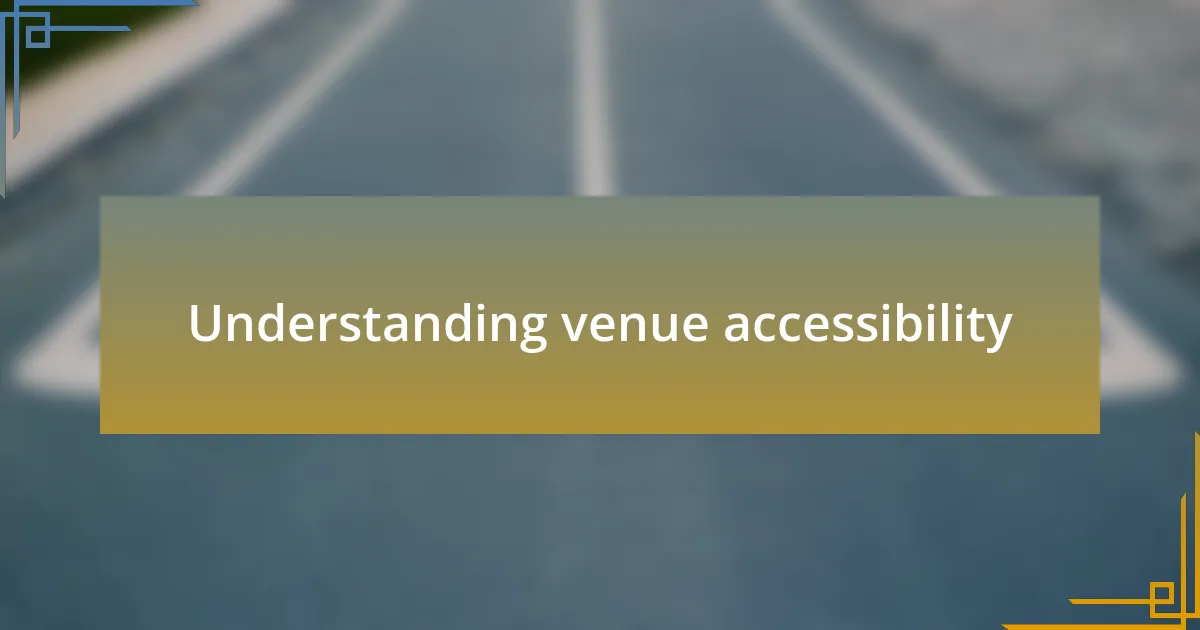
Understanding venue accessibility
When I first began evaluating venue accessibility, it struck me how often this crucial aspect is overlooked. I remember visiting a charming little venue that was advertised as accessible, only to find a series of steep steps leading to the entrance. In moments like these, I can’t help but wonder, how many guests might have felt unwelcome or even discouraged from attending?
Accessibility isn’t just about ramps and elevators; it’s about creating an inclusive experience for everyone. I recall a wedding I attended where the venue had thoughtfully designed spaces that catered to all mobility levels, giving every guest the chance to participate fully. It was heartwarming to see a family member with mobility issues feeling at ease, as they could navigate the space without barriers.
In my view, understanding venue accessibility is also about communication. During my evaluations, I’ve often reached out to venue managers with questions about their accommodations, sometimes discovering that their confidence in accessibility features doesn’t fully align with what’s actually available. Have you ever found yourself in a situation where a venue’s description didn’t match reality? Those experiences remind me of the importance of thorough research and open dialogue when planning an event.
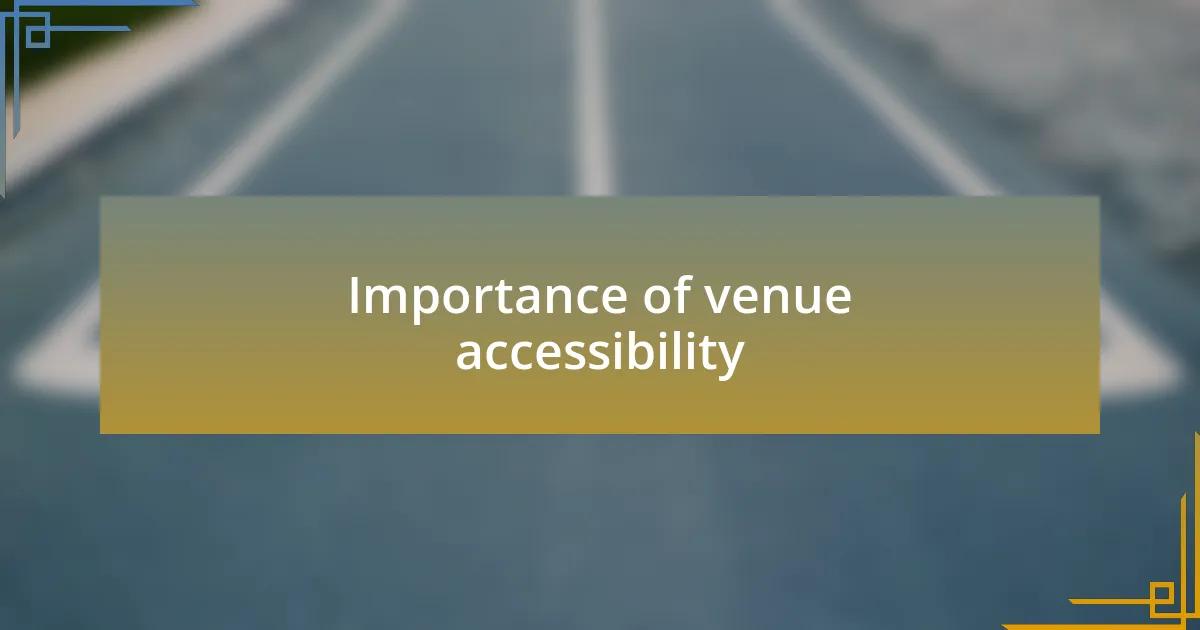
Importance of venue accessibility
Ensuring that a venue is accessible is essential for creating a welcoming environment for all guests. I vividly recall a wedding where the couple made a point of choosing an accessible venue, and it made an incredible difference. One of the attendees, who used a wheelchair, expressed immense gratitude for not having to navigate stairs or cramped hallways while trying to celebrate with loved ones. It really showcased the profound impact a thoughtful choice can have.
Accessibility goes beyond just the physical aspects of a venue; it encompasses the overall atmosphere too. I once attended a wedding at a venue that catered to all needs, including Braille signage and quiet spaces for guests who might become overwhelmed. Hearing the joyful laughter from every corner of the room that day reminded me how crucial it is for everyone to feel included, irrespective of their personal challenges.
Have you ever noticed how certain details can make guests feel more valued? It struck me during my evaluations how venues that prioritize accessibility often have a more vibrant and joyous atmosphere. When people feel comfortable and included, they fully immerse themselves in the celebration. That’s why, in my opinion, venue accessibility should always be at the forefront when planning an unforgettable wedding experience.
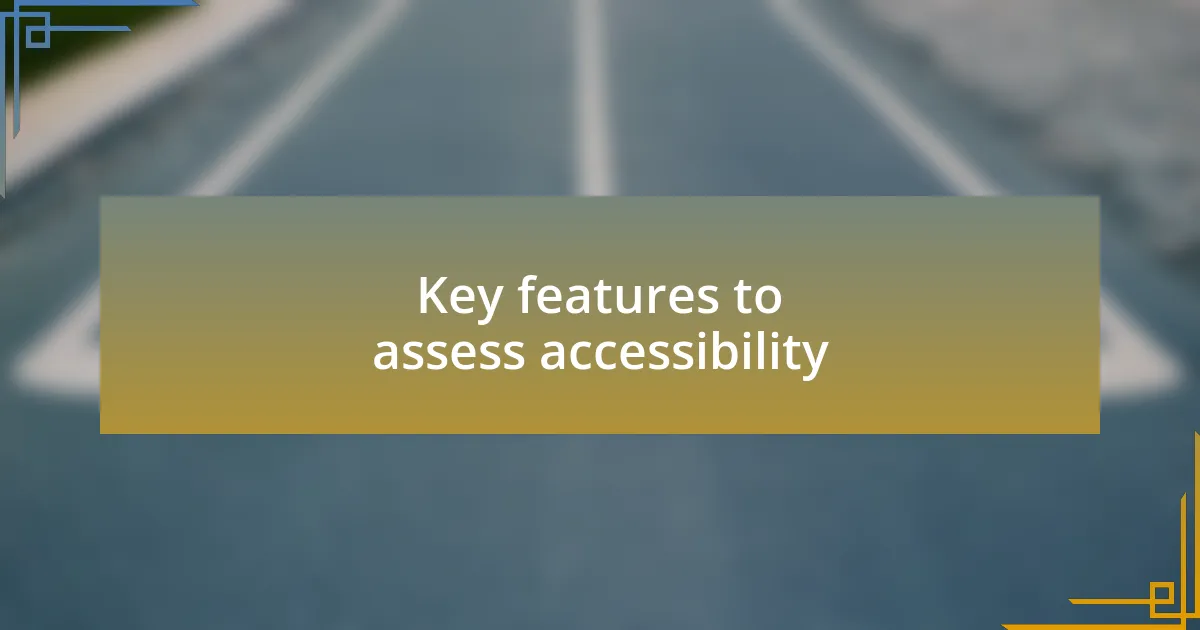
Key features to assess accessibility
Assessing venue accessibility involves several key features, starting with parking options. I remember visiting a venue where the designated accessible parking spots were conveniently located near the entrance. It was a small detail, but you could sense the relief among guests who didn’t have to struggle from a far-off lot. Couldn’t parking ease the stress before the celebration even starts?
Another critical factor is the interior layout. I still think about a wedding I attended in a place with wide hallways and spacious rooms. The open design made it easy for guests to navigate without feeling cramped. When I saw one guest with a service dog comfortably moving around, it really drove home the importance of a well-thought-out space that accommodates everyone.
Communication accessibility shouldn’t be overlooked, either. After scouring venues, I found one that offered audio descriptions and sign language interpreters. It made such a difference during the ceremony when everyone – regardless of hearing ability – was able to enjoy the heartfelt exchanges between the couple. Why wouldn’t a venue prioritize this aspect to enhance the experience for every guest?
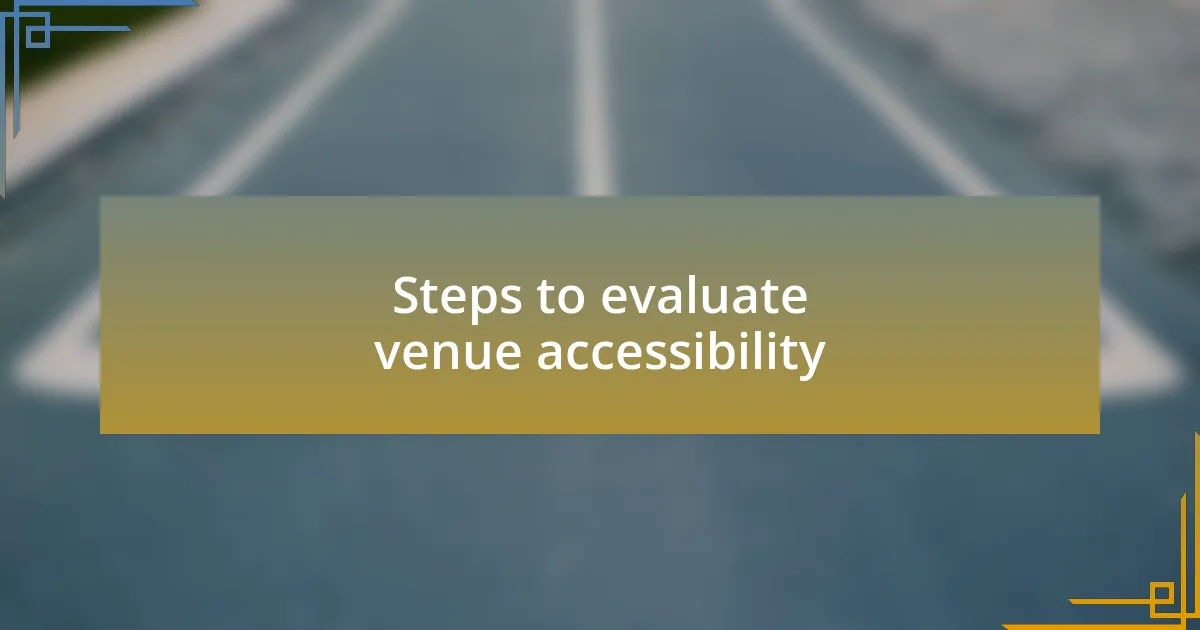
Steps to evaluate venue accessibility
To effectively evaluate venue accessibility, start by examining the entrance and exits. I once attended a wedding at a lovely venue with a grand entrance, but I noticed that there were important steps at the main door. It struck me how that single choice could exclude guests who used wheelchairs or had mobility challenges. Is it too much to ask that every invited guest can enter a place meant for celebration?
Next, I find it essential to assess restroom facilities. During another venue visit, I discovered a spacious restroom equipped with grab bars and enough room for wheelchair maneuverability. I felt relieved knowing everyone would have a comfortable experience. Why take chances when accessible restrooms could make all the difference for guests in need?
Lastly, consider the venue’s communication tools, like printed materials and digital accessibility. I remember a venue that provided clear signage and alternative formats for programs. This thoughtful touch facilitated a seamless experience for all, creating an inclusive atmosphere. Shouldn’t every venue ensure that everyone feels informed and involved?
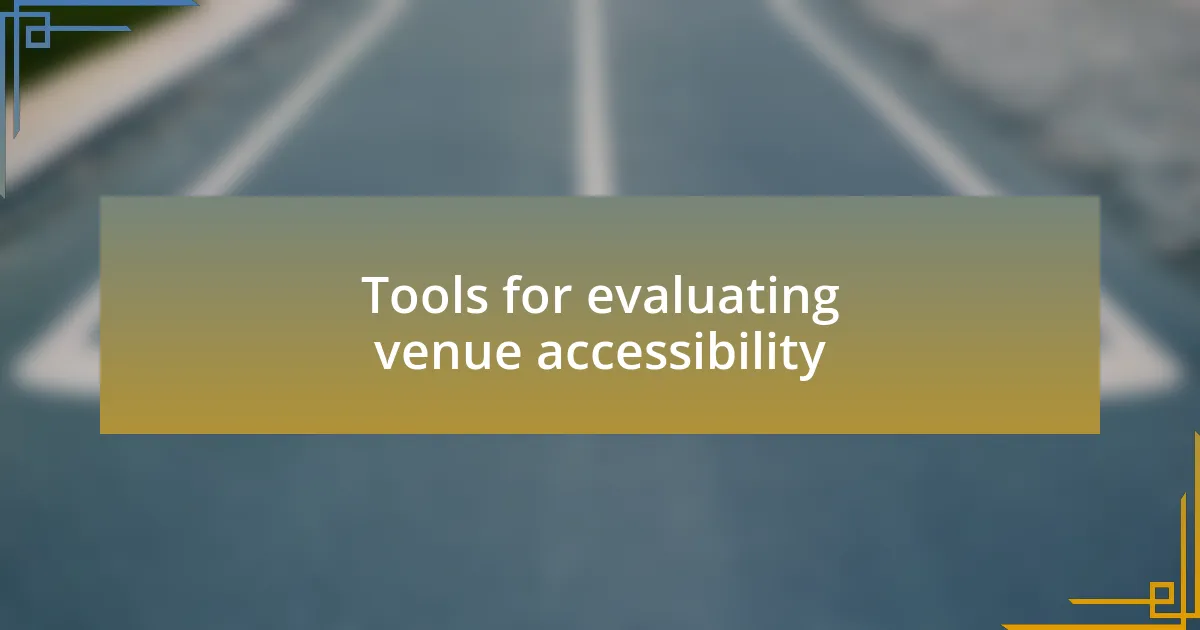
Tools for evaluating venue accessibility
When it comes to tools for evaluating venue accessibility, I’ve found that online resources can be a real game-changer. Websites like AccessNow let you find detailed accessibility information about venues in your area. I remember the first time I used it; I was planning a friend’s wedding and discovered a venue’s hidden features that I wouldn’t have known about otherwise. Isn’t it incredible how technology can open doors—literally?
On-site assessments also play a crucial role. I often bring a checklist with me that includes key accessibility features, such as parking availability and path surfaces. Once, while evaluating a rustic venue, I realized the gravel pathways could pose a challenge for some guests. Reflecting on those details made me think: should aesthetic choices compromise accessibility?
Lastly, don’t underestimate the power of direct communication with venue staff. I once called a venue specifically to inquire about their accessibility offerings and was pleasantly surprised by how knowledgeable and accommodating they were. Engaging with staff not only confirms what you’ve learned but also reveals their genuine commitment to creating an inclusive experience. Isn’t it telling when a venue prioritizes open dialogue?
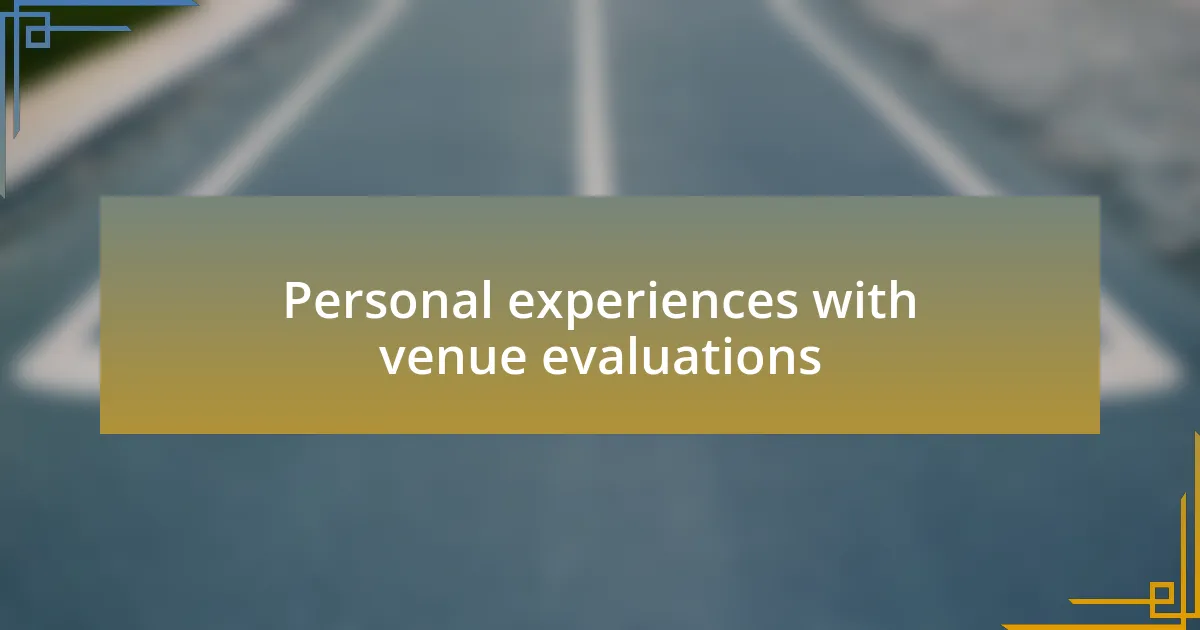
Personal experiences with venue evaluations
When evaluating venues, I’ve found that my personal experiences often shape my understanding of what accessibility truly means. I vividly recall a visit to a beautiful vineyard. While the views were breathtaking, I noticed that the main entrance had a steep set of stairs. It dawned on me how easily a stunning venue can overlook essential accessibility features. Have you ever felt torn between aesthetic beauty and practical needs?
Another memorable experience happened at a banquet hall, where I was initially captivated by its grandeur. However, during my tour, I realized the restrooms were located far from the main event area. It struck me how important it is for venues to consider the flow of movement for all guests, especially those with mobility challenges. I often ask myself: how can we celebrate love if we inadvertently create barriers for some?
Lastly, my conversations with engaged couples have significantly influenced my perspective. I remember discussing venue options with a friend who uses a wheelchair. Hearing her experiences made it clear that small modifications, like ramp placements and accessible restrooms, could become major decision factors in venue selection. Isn’t it fascinating how sharing different viewpoints can reshape our understanding of accessibility?
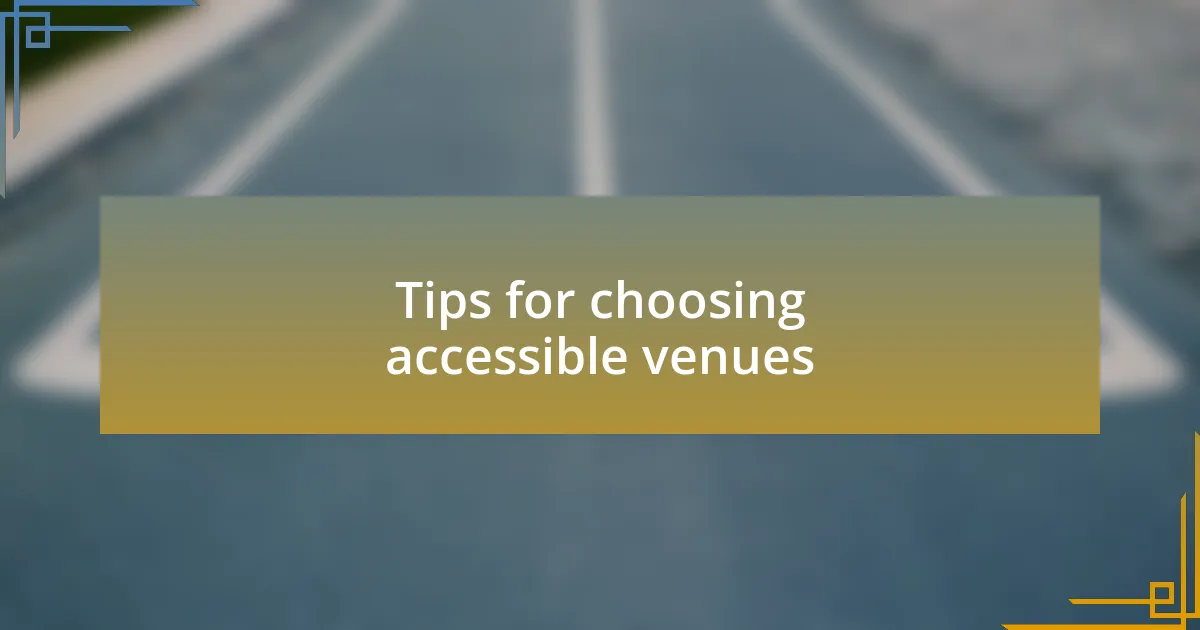
Tips for choosing accessible venues
When it comes to choosing accessible venues, I always recommend starting with a physical visit. I remember once going to a lovely community center for a friend’s wedding. As soon as I entered, I noticed the ramps and wide doors. It felt welcoming, and I understood just how crucial those features are in creating an inviting atmosphere. Have you ever walked into a space and instantly felt at ease? That’s what accessibility should feel like.
Another tip is to consider transportation options. During my search for a venue, I encountered one that had ample parking but was several miles away from public transport. This raised a flag for me, as not all guests may have access to a car. I learned that the journey to the venue should be as easy as the celebration itself. What good is a beautiful venue if getting there becomes a challenge?
Engaging with the venue staff can also reveal valuable insights about their commitment to accessibility. I once spoke with a venue coordinator who proudly informed me about their training in accommodating various needs. I felt reassured knowing they were proactive about inclusivity. Have you thought about how staff attitudes can significantly impact the overall experience? It’s worth asking the right questions to assess their dedication to making every guest feel welcome.